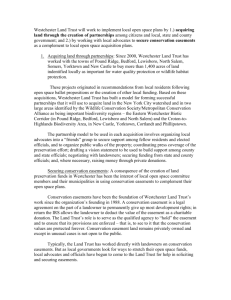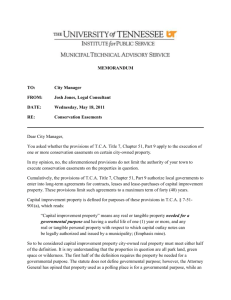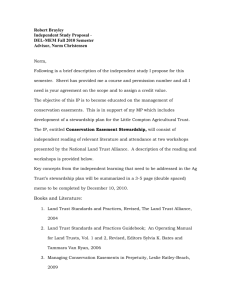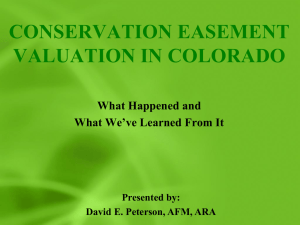View as DOC - Lerch, Early & Brewer
advertisement
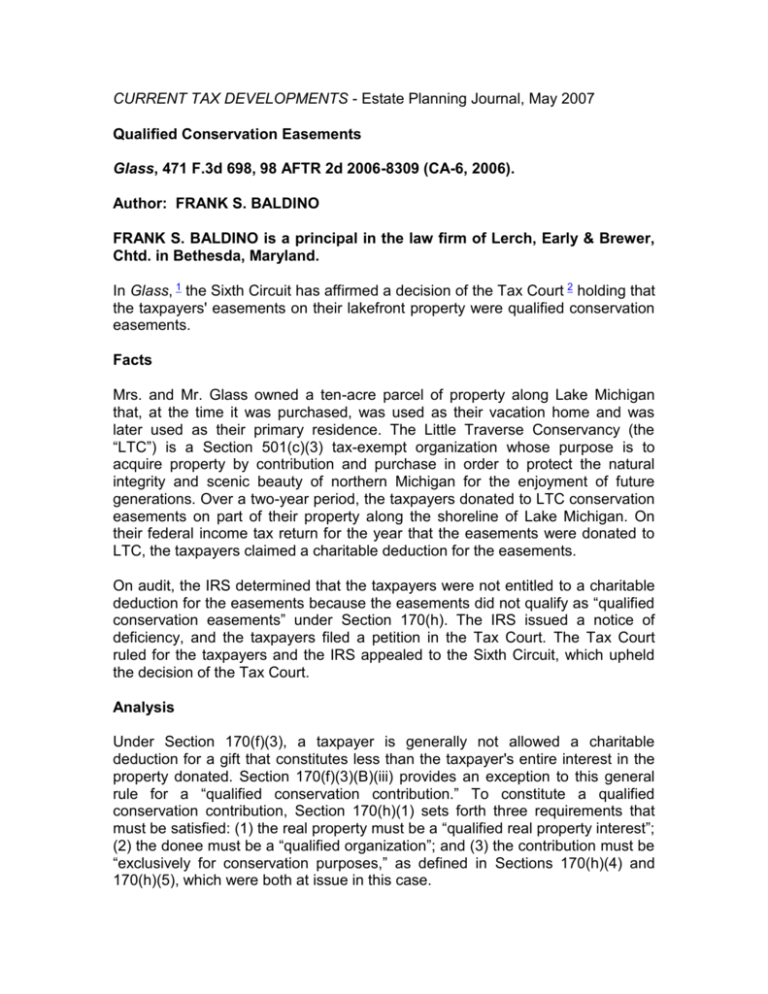
CURRENT TAX DEVELOPMENTS - Estate Planning Journal, May 2007 Qualified Conservation Easements Glass, 471 F.3d 698, 98 AFTR 2d 2006-8309 (CA-6, 2006). Author: FRANK S. BALDINO FRANK S. BALDINO is a principal in the law firm of Lerch, Early & Brewer, Chtd. in Bethesda, Maryland. In Glass, 1 the Sixth Circuit has affirmed a decision of the Tax Court 2 holding that the taxpayers' easements on their lakefront property were qualified conservation easements. Facts Mrs. and Mr. Glass owned a ten-acre parcel of property along Lake Michigan that, at the time it was purchased, was used as their vacation home and was later used as their primary residence. The Little Traverse Conservancy (the “LTC”) is a Section 501(c)(3) tax-exempt organization whose purpose is to acquire property by contribution and purchase in order to protect the natural integrity and scenic beauty of northern Michigan for the enjoyment of future generations. Over a two-year period, the taxpayers donated to LTC conservation easements on part of their property along the shoreline of Lake Michigan. On their federal income tax return for the year that the easements were donated to LTC, the taxpayers claimed a charitable deduction for the easements. On audit, the IRS determined that the taxpayers were not entitled to a charitable deduction for the easements because the easements did not qualify as “qualified conservation easements” under Section 170(h). The IRS issued a notice of deficiency, and the taxpayers filed a petition in the Tax Court. The Tax Court ruled for the taxpayers and the IRS appealed to the Sixth Circuit, which upheld the decision of the Tax Court. Analysis Under Section 170(f)(3), a taxpayer is generally not allowed a charitable deduction for a gift that constitutes less than the taxpayer's entire interest in the property donated. Section 170(f)(3)(B)(iii) provides an exception to this general rule for a “qualified conservation contribution.” To constitute a qualified conservation contribution, Section 170(h)(1) sets forth three requirements that must be satisfied: (1) the real property must be a “qualified real property interest”; (2) the donee must be a “qualified organization”; and (3) the contribution must be “exclusively for conservation purposes,” as defined in Sections 170(h)(4) and 170(h)(5), which were both at issue in this case. Section 170(h)(4)(A)(ii) defines “conservation purpose” as “the protection of a relatively natural habitat of fish, wildlife, or plants, or similar ecosystem.” Reg. 1.170A-14(d)(3) repeats the statutory language but adds the requirement that such “relatively natural habitat” must be “significant.” The Regulation also states that significant habitats include, but are not limited to, habitats for rare, endangered, or threatened species of animal, fish, or plants. With respect to the exclusivity aspect of the third statutory requirement, Section 170(h)(5)(A) provides that “a contribution shall not be treated as exclusively for conservation purposes unless the conservation purpose is protected in perpetuity.” The IRS presented three arguments to the Sixth Circuit in Glass. First, the IRS asserted that the Tax Court's construction of Reg. 1.170A-14(d)(3) was erroneous because it read the word “significant” out of the Regulation. Second, the IRS contended that the easements failed to serve the stated conservation purposes because the property subject to the easements was too small, the easements allowed the taxpayers too many retained rights, and the easements failed to restrict the building rights of neighboring property owners. Third, the IRS argued that the conservation purposes of the easements were not protected in perpetuity, and that therefore the easements were not exclusively for conservation purposes. The Sixth Circuit rejected each of these arguments. With respect to the first argument, the appellate court noted that the Regulations clearly provide that “significant habitats” include habitats for rare, endangered, or threatened species of animal, fish, or plants. The IRS argued that there was no testimony in the Tax Court that any rare, endangered, or threatened species of animal, fish, or plants were actually sighted living on the taxpayers' property. The Sixth Circuit disagreed with the IRS and upheld the Tax Court's finding that the taxpayers' property was a habitat for threatened species of animals and plants. The Sixth Circuit, although recognizing that private letter rulings cannot be used as precedent, cited to Ltr. Rul. 200403044, in which the IRS stated that the conservation easement involved in that ruling was “potentially the habitat for several endangered, threatened or rare plant and animal species” (emphasis added). The Sixth Circuit rejected the IRS's second argument that the terms of the easements failed to prohibit activity or use of the property that was inconsistent with the stated conservation purposes of the easements. The court of appeals agreed with the Tax Court that the terms of the easements limited the taxpayers' reserved rights so as to ensure that the plant and wildlife habitats were protected. In addition, the Sixth Circuit held that there is no statutory or regulatory requirement that requires a minimum size for a qualifying conservation easement. The Sixth Circuit cited to Ltr. Rul. 8546112, in which the IRS allowed a charitable deduction for a conservation easement on a three-quarter-acre parcel. The Sixth Circuit reasoned that it is not the size of the easement that is determinative but rather whether the easement permits any retained use that undermines the stated conservation purpose of the easement. Similarly, the Sixth Circuit rejected the IRS's argument that the Tax Court erred by failing to consider the building rights of neighboring property owners. The Sixth Circuit held that there is no statutory or regulatory provision requiring consideration of neighboring property owners' building rights when determining whether a conservation easement is a “qualified conservation contribution.” The IRS's final argument was that the Tax Court erred in finding that the easements were “exclusively for conservation purposes,” as required under Section 170(h)(5)(A). The Tax Court found that LTC was a legitimate, longstanding nature conservancy that dealt at arm's length with the taxpayers, that LTC had the financial resources to enforce the easements in perpetuity, that holding the easements was directly related to LTC's tax-exempt purposes, and that the easements were legally enforceable in perpetuity. The Sixth Circuit agreed with the Tax Court that the easements met the “exclusively for conservation purposes” requirement. Comments This decision points out that there is no statutory or regulatory requirement that the species of animal or plant intended to benefit from the easement actually be living on the property at the time of the donation, nor is there a requirement regarding a minimum size of the property subject to a conservation easement. From the facts presented in the Tax Court opinion and the Sixth Circuit opinion, it is difficult understand why the IRS brought this case initially or pursued the subsequent appeal. This and similar cases that are in the pipeline will be significant in establishing the parameters of Section 170(h) for both income tax and estate tax purposes. 1. 98 AFTR 2d 2006-8309, 471 F3d 698, 2007-1 USTC ¶50111 (CA-6, 2006). 2. Glass, 124 TC 258 (2005). 687,711v1
